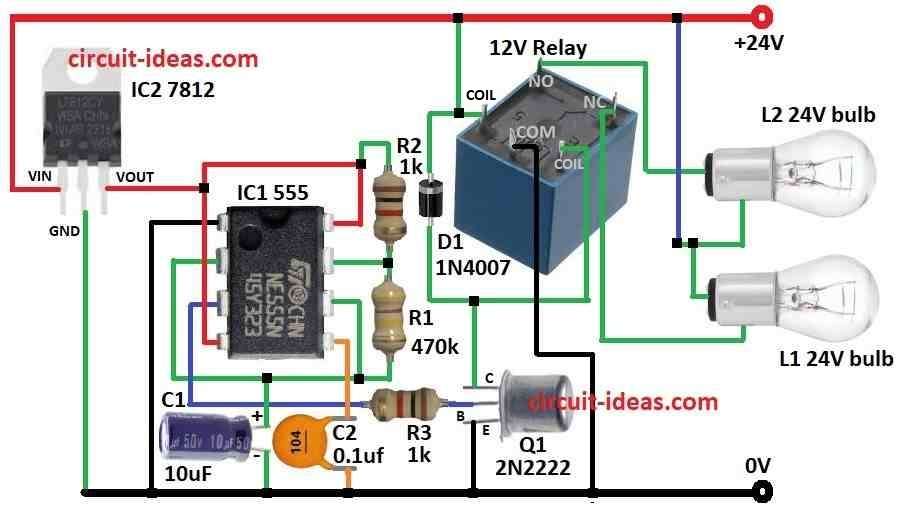24V Flasher Circuit can ON-OFF 24V thing like lightbulb again and again.
Can use to turn signal or warning flash light.
This circuit uses IC 555 is common for making timer or flasher.
We can change flash speed by adding resistor and capacitor to IC 555.
This way is not so flexible but easy.
Also we can make simple flasher using transistor and resistor without IC.
Circuit Working:

Parts List:
| Component Type | Description | Quantity |
|---|---|---|
| Resistors | 1k 1/4 watt | 2 |
| 470k 1/4 watt | 1 | |
| Capacitors | Ceramic 0.1μF | 1 |
| Electrolytic 10μF 50V | 1 | |
| Semiconductors | IC 555 | 1 |
| IC 7812 | 1 | |
| Transistor 2N2222 | 1 | |
| Diode 1N4007 | 1 | |
| 12V Relay | 1 | |
| 24V Bulbs | 2 |
Two bulbs in flasher circuit are controlled by relay.
Both bulbs positive sides connect together to 24V power.
Negative sides go to relay for ON/OFF control.
Relay have 3 main pins:
- COM (Common) which is always connected to relay.
- NO (Normally Open) is not connected at first but connected when relay is ON.
- NC (Normally Closed) is connected at first and then disconnected when relay is ON.
Because of this only one bulb lights at a time.
555 IC for Timing:
Relay must turn ON/OFF again and again to make flash.
IC 555 is used for making time signals.
We use IC 555 in astable mode which gives continuous pulse with ON time (Ton) and OFF time (Toff).
Bulb Control with Timing:
555 output controls bulbs.
Bulb 1 is ON during Ton
Bulb 2 is ON during Toff
This process will be shown in simulation.
Powering the Circuit:
Circuit runs on 24V but relay and IC 555 need lower voltage.
IC 7812 voltage regulator changes 24V to 5V for IC 555 and relay.
Boosting 555 Output with Transistor:
Sometimes IC 555 output with pin 3 is not strong for relay.
So 2N2222 NPN transistor is used to increase power.
555 sends signal to transistor base through resistor.
Transistor acts like switch and gives enough current to turn relay ON/OFF.
Formulas:
Flash rate how fast the bulbs blink depends on 2 parts in 555 IC astable mode:
Resistor R1 which connects pin 1 and pin 8 of 555 IC.
Capacitor C1 which connects pin 2 and pin 6 of 555 IC.
Flash rate formula is:
F = 1.44 / (R1 × C1)
where:
- F is the flash rate in Hz
- R1 is the resistor value in ohms Ω
- C1 is the capacitor value in farads F
Change R1 or C1 to control flash speed.
Higher R1 or C1 then slower will be the flash.
Lower R1 or C1 then faster will be the flash.
How to Build:
To build a 24V Flasher Circuit we need to follow the below mentioned steps for connections:
- Pin 1 of IC1 555 connects to ground
- Pin 2 connect to pin 6 also connect C1 capacitor from pin 2 and pin 6 to ground
- Pin 3 connects to base of Q1 transistor through R3 resistor
- Pin 4 & pin 8 connects to Vout of IC2 7812
- Pin 5 connects to ground through C2 capacitor
- R1 connects between pin 6 and pin 7
- R2 connects from pin 7 to positive supply Vout
Power Supply IC2 7812 Regulator:
- Vin of IC2 connects to +24V
- GND of IC2 connects to 0V ground
- Vout connects to positive rail for IC1 555
Transistor and Relay Connection:
Q1 collector to COM pin of 12V relay
- Q1 base connects from pin 3 of IC1 555 through R3
- Q1 emitter connects to ground
Relay coil:
- One pin connects to +24V
- Other pin connects to collector of Q1
- Relay COM pin connects to ground
- Relay NO pin connects to L2 bulb 2
- Relay NC pin connects to L1 bulb 1
- D1 diode connects across relay coil pins with reverse polarity for protection
Safety Notes:
- Be careful with 24V can shock
- Use proper voltage source
- Double check the wiring
- Safety first always when working with circuits
Conclusion:
In this 24V Flasher Circuit IC 555 controls bulb flash speed
The transistor and relay handle bigger current
IC 7812 gives safe voltage to IC 555
While building the circuit be careful and should stay safe!
Leave a Reply